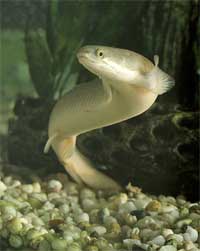|

 All shapes and sizes: Depending on their species, eels can reach from 10 cm to 3 m, and
weigh up to 65 kg. The number of rays of the gill webbing ranges
from 6 to 51, though sometimes they are absent altogether. Their
fins are always spineless. The back and anal fins are long, usually
connecting with the tail fin. The belly and chest fins are absent.
The shoulder girdle is separate from the skull. The scales are cycloid
or absent. All shapes and sizes: Depending on their species, eels can reach from 10 cm to 3 m, and
weigh up to 65 kg. The number of rays of the gill webbing ranges
from 6 to 51, though sometimes they are absent altogether. Their
fins are always spineless. The back and anal fins are long, usually
connecting with the tail fin. The belly and chest fins are absent.
The shoulder girdle is separate from the skull. The scales are cycloid
or absent.

 Hideout: Most eels prefer to dwell in shallow waters, hide at the bottom
layer of the ocean, sometimes in holes. Only the Anguillidae family
comes to fresh water to dwell there (not to breed). Some eels dwell
in deep water (in case of family Synaphobranchidae, this comes to
a depth of 4,000 m), or are active swimmers (the family Nemichthyidae
- to the depth of 500 m). Hideout: Most eels prefer to dwell in shallow waters, hide at the bottom
layer of the ocean, sometimes in holes. Only the Anguillidae family
comes to fresh water to dwell there (not to breed). Some eels dwell
in deep water (in case of family Synaphobranchidae, this comes to
a depth of 4,000 m), or are active swimmers (the family Nemichthyidae
- to the depth of 500 m).
The life cycle of the eel was a mystery for a very long time, because
larval eels look very different from adult eels, and were thought
to be a separate species. See eel life history.
An eel sandwich: Freshwater eels (unagi) and marine eels (Conger eel, anago) are
commonly used in Japanese cuisine. Eels are used in Cantonese and
Shanghai cuisine too. The European eel and other freshwater eels
are eaten in Europe, the United States, and other places around
the world. A traditional London food is jellied eels. The Basque
delicacy, angulas, consists of deep-fried elvers.
Uniquely in Europe, hand netting is the only legal way of catching
eels in England, and has been practiced for thousands of years on
the River Parrett and River Severn.
Eel skins are used in some wallets and purses
All text is available under the terms
of the GNU Free Documentation License
|